Tags
In the spirit of my ongoing compaign to embrace the seasonal urge to clean house, herewith the second of two revisitations of projects past. This short interlude addresses some nagging concerns about the performance of a Seiko 6139-6012 from June 1975 whose restoration marked my first experience of grappling properly with the mysteries of the Seiko 6139 vertical clutch single register automatic chronograph movement.
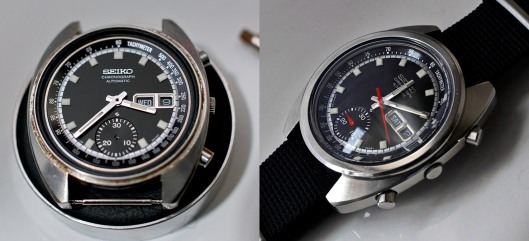 My impulse to take another look at this one was born from a recent awareness that the time-keeping was somewhat erratic and I felt that performing another service ought to resolve any ongoing issues. It is probably worth acknowledging too that the first time around, I had only performed a demi-service, having focussed solely on the chronograph side of the movement. Consequently, this watch represents unfinished business, regardless of its apparent state of ill-health.
My impulse to take another look at this one was born from a recent awareness that the time-keeping was somewhat erratic and I felt that performing another service ought to resolve any ongoing issues. It is probably worth acknowledging too that the first time around, I had only performed a demi-service, having focussed solely on the chronograph side of the movement. Consequently, this watch represents unfinished business, regardless of its apparent state of ill-health.
I should add at this point that I embarked on this one with no real intent to document it and consequently rather enjoyed shaking off the shackles of the obligation to photograph every step. However, this particular project has thrown up a series of infuriating headaches, the resolution of which has required me to embark on an iterative cycle of serial part exchanges, the result of which has highlighted a couple of useful observations that readers of this blog may find mildly diverting. The following narrative therefore may not be especially chronologically coherent but let’s give it a go and see where we end up.
The specific issue I was having with this watch was that I was seeing significant sudden fluctuations in the timing curve that would gradually settle and then repeat. The movement was also displaying rather poor amplitude that may have been related to the fact that I did not clean the mainspring the first time around.
So let’s dive in. The easy part of the process is to disassemble the movement and given that I’ve documented 6139B deconstructions on a number of occasions in the past, I present only a fragment of evidence to illustrate that process.
 The movement parts found their way into the watch cleaning machine following a blitz in the ultrasonic bath and emerged looking squeaky clean.
The movement parts found their way into the watch cleaning machine following a blitz in the ultrasonic bath and emerged looking squeaky clean.
 The satisfactory operation of any movement is driven by the mainspring and so it is here that we begin:
The satisfactory operation of any movement is driven by the mainspring and so it is here that we begin:
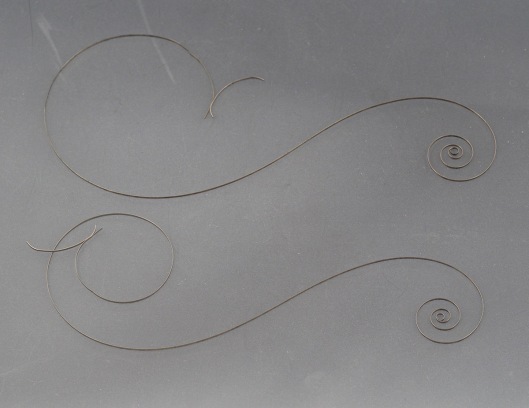 The upper of the two mainsprings in the photo above is the original mainspring, the lower a mainspring taken from a Seiko 6106C. You will notice that the 6139 mainspring has lost some of its bounce at the tail end and probably should be replaced. The part number for the 6139 mainspring is 401616 and supply has long since dried up. The 6139B is based on the 6106A calibre and consequently, a 6106, 6105 or 6119 mainspring will fit and potentially do the job. However, the part number, 401615, differs by one digit compared to that of the 6139 which suggests that there are differences that relate to the requirement in the 6139 for the mainspring to drive a rather more demanding gear train. My measurements of the two suggest that the 401616 is slightly thicker at 0.12 mm compared to the 0.11 mm of the 6106 mainspring and so substituting a 401615 may not provide as much power as the movement demands. Nevertheless, I opt to give the 6106 mainspring a try.
The upper of the two mainsprings in the photo above is the original mainspring, the lower a mainspring taken from a Seiko 6106C. You will notice that the 6139 mainspring has lost some of its bounce at the tail end and probably should be replaced. The part number for the 6139 mainspring is 401616 and supply has long since dried up. The 6139B is based on the 6106A calibre and consequently, a 6106, 6105 or 6119 mainspring will fit and potentially do the job. However, the part number, 401615, differs by one digit compared to that of the 6139 which suggests that there are differences that relate to the requirement in the 6139 for the mainspring to drive a rather more demanding gear train. My measurements of the two suggest that the 401616 is slightly thicker at 0.12 mm compared to the 0.11 mm of the 6106 mainspring and so substituting a 401615 may not provide as much power as the movement demands. Nevertheless, I opt to give the 6106 mainspring a try.
 The maximum theoretical torque output of a mainspring increases with the third power of the spring thickness and so using the 6106 mainspring in principle should result in a decrease in torque of about 23%. We shall see in due course whether this turns out to hinder progress.
The maximum theoretical torque output of a mainspring increases with the third power of the spring thickness and so using the 6106 mainspring in principle should result in a decrease in torque of about 23%. We shall see in due course whether this turns out to hinder progress.
With that decision made, I am free to build up the chronograph side to the point where we can get it running and see whether the more forensic clean this time around has dispersed the gremlins. Here we are nearing the end of that process, with the two coupling levers in position, the hammer, springs, minute recording wheel and intermediate wheel all fitted.
 The chronograph bridge comes next, followed by the pallet fork, its bridge and the balance but feeding a full wind of power sees our problems largely unresolved. Amplitude remains underwhelming and the fluctuation in timing issue persists. Drat!
The chronograph bridge comes next, followed by the pallet fork, its bridge and the balance but feeding a full wind of power sees our problems largely unresolved. Amplitude remains underwhelming and the fluctuation in timing issue persists. Drat!
The variational timing issue must be related to some sort of impediment to the free rotation of one or more of the gear train, most probably the escape wheel, third wheel or chronograph wheel (the period between timing fluctuations being too short for it realistically to be the centre wheel) and the amplitude problem could be related to the mainspring or perhaps to the pallet fork.
My efforts to track down the problem were fraught and required perhaps 6 or 7 rebuilding and dismantling cycles involving the replacement, one at a time, of the: train wheel bridge (one or two of whose jewels were slightly chipped); the chronograph bridge (ditto); the third wheel and finally the escape wheel.
While we are on the subject of escape wheels, I have noticed that there appears to be a degree of received wisdom in circulation on the internet that an escape wheel from the 17 jewel versions of the base movement family could serve as a workable substitute, the availability of 6139 escape wheels being sparse to say the least. I believe I am now in a position to dispel any suggestion that the part number 251611 as fitted to 17 J versions of the 6105, 6106 and 6119 is essentially the same as the analogous 251612 part as fitted to the 17 J 6139B. The photo below is a merging two, one taken of the 6139B escape wheel pinion (left) and one of the 6106C escape wheel pinion (right).
 You should be able to discern that the 6139 escape wheel pivots (left) are longer than those of the 6106 (right) and that there are some other subtle differences in the profiles of the broader parts of both pivots. This does not mean that the other escape wheel could not be called into service as a temporary fix but the pivots may not properly engage in the jewel holes in all positions. For your amusement, here’s a short clip of the gear train in motion with a couple of clicks of power wound into the mainspring:
You should be able to discern that the 6139 escape wheel pivots (left) are longer than those of the 6106 (right) and that there are some other subtle differences in the profiles of the broader parts of both pivots. This does not mean that the other escape wheel could not be called into service as a temporary fix but the pivots may not properly engage in the jewel holes in all positions. For your amusement, here’s a short clip of the gear train in motion with a couple of clicks of power wound into the mainspring:
This painful process brings us to the point where we appear to have eliminated the timing fluctuations (I suspect the finger of blame rested with a combination of the third wheel and the chipped bearings in the bridges) but the poor amplitude persisted as did some significant positional variation in amplitude. I wondered at this point whether my decision to use the 6106 mainspring had been altogether wise and at the risk of giving the impression that I was floundering around for a solution I decided to see if I could source a generic mainspring to at least restore some of the torque that the original mainspring would have supplied when new.
According to my calipers, the dimensions of the 6139B mainspring (401616) are:
1.05 x 0.12 x 400 x 10.5 mm
The same caliper suggests the 6106 mainspring (401615) is a little longer and a tad thinner:
1.05 x 0.11 x 410 x 10.5 mm.
The Generale Ressorts catalogue suggests the GR2534X as a suitable replacement. Its thickness is 0.115, half way between the two but I’ve had one previous poor experience with this mainspring in a previous 6139 project and so am not inclined to go for that one again. Instead, I opt to try a GR2535X whose thickness, at 0.12 mm, is the same as the 401616 but which is quite a bit shorter at 340 mm. I figure the extra torque trumps power reserve in this instance and opt to give it a try.
With this new mainspring fitted, we seem to have considerably improved amplitude dial down but it is still struggling dial up and to make matters worse, runs very fast in this position.
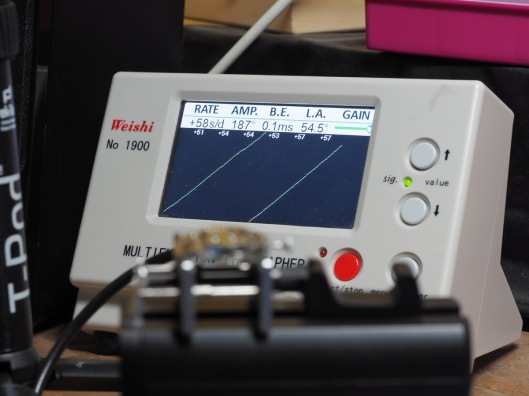 At this point, the finger of suspicion points to the balance. The condition of the hairspring on the existing balance was less than perfect and I suspected that perhaps it was also out of flat. My stash of useable 6139 parts has been largely exhausted over the years and so I resolved to farm a balance from a spare 6106.
At this point, the finger of suspicion points to the balance. The condition of the hairspring on the existing balance was less than perfect and I suspected that perhaps it was also out of flat. My stash of useable 6139 parts has been largely exhausted over the years and so I resolved to farm a balance from a spare 6106.
 In the photo above, you should be able to see that with the stud holder and regulator arm appropriately oriented, the impulse jewel on the 6106 balance (right) is aligned 90 degrees anticlockwise relative to that on the 6139B balance wheel. When transplanting from one to the other, the hairspring collar needs to be rotated 90 degrees to properly align the impulse jewel so that it sits correctly between ends of the pallet fork. I should note that the balance on the right is a junk spare called into service for the purpose of illustrating my point and is not the balance transplanted to the 6139. With the replacement balance fitted, we can get a sense of how easy it is to get things wrong if not paying proper attention. In the photo below, the stud is sitting too high in the stud holder which is causing the hairspring to dish upwards, preventing it from sitting flat.
In the photo above, you should be able to see that with the stud holder and regulator arm appropriately oriented, the impulse jewel on the 6106 balance (right) is aligned 90 degrees anticlockwise relative to that on the 6139B balance wheel. When transplanting from one to the other, the hairspring collar needs to be rotated 90 degrees to properly align the impulse jewel so that it sits correctly between ends of the pallet fork. I should note that the balance on the right is a junk spare called into service for the purpose of illustrating my point and is not the balance transplanted to the 6139. With the replacement balance fitted, we can get a sense of how easy it is to get things wrong if not paying proper attention. In the photo below, the stud is sitting too high in the stud holder which is causing the hairspring to dish upwards, preventing it from sitting flat.
 With it in this state the amplitude collapses dial up and the watch runs fast but dial down the amplitude is ok and the watch runs at an even rate. This would explain the issue I was having with the original mainspring although in that case, the dishing of the mainspring appeared not to be related to the position of the stud. A quick adjustment to the stud position and I believe we may finally have banished all of the gremlins.
With it in this state the amplitude collapses dial up and the watch runs fast but dial down the amplitude is ok and the watch runs at an even rate. This would explain the issue I was having with the original mainspring although in that case, the dishing of the mainspring appeared not to be related to the position of the stud. A quick adjustment to the stud position and I believe we may finally have banished all of the gremlins.
Now that I am satisfied with the operation of the movement, I can assemble the calendar side components and refit the dial and hands.
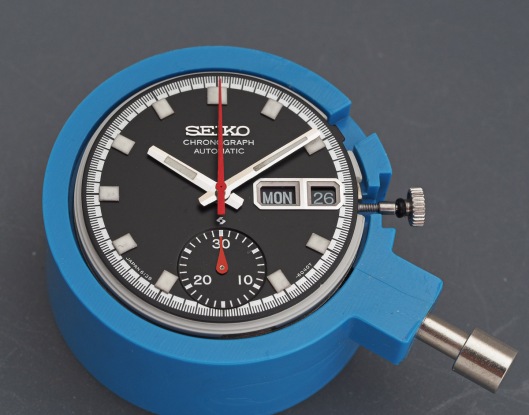 The movement slips back into the case and I can refit the autowinding mechanism.
The movement slips back into the case and I can refit the autowinding mechanism.
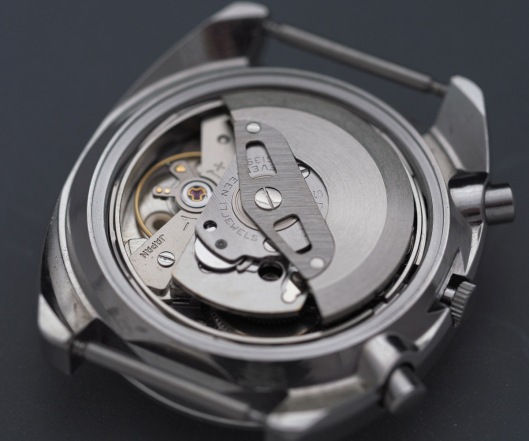 A quick final regulation and it looks like this particular loose end is properly tied up.
A quick final regulation and it looks like this particular loose end is properly tied up.
 230 degrees amplitude is pretty decent with these movements and I am not inclined to tinker any more or consider transplanting the mainspring again. In spite of its shorter length, the power reserve still exceeds 33 hours which is plenty. I finish this one off by replacing the black NATO strap that it has become accustomed to with its original steel bracelet.
230 degrees amplitude is pretty decent with these movements and I am not inclined to tinker any more or consider transplanting the mainspring again. In spite of its shorter length, the power reserve still exceeds 33 hours which is plenty. I finish this one off by replacing the black NATO strap that it has become accustomed to with its original steel bracelet.
 There was a time when I felt mildly intimidated by these movements, spooked I think by their seeming sensitivity to imperfections in the running train and the number of variables that needed to be considered in order to get them to run true and to function correctly. To an extent, this lack of confidence has sustained to the present but this recent experience has revealed to me that in fact black magic is not mandatory in getting a 6139 to run properly. Just cold, hard, forensic application, a methodical approach to snagging and problem-solving and yes, the occasional splash of desperate measures.
There was a time when I felt mildly intimidated by these movements, spooked I think by their seeming sensitivity to imperfections in the running train and the number of variables that needed to be considered in order to get them to run true and to function correctly. To an extent, this lack of confidence has sustained to the present but this recent experience has revealed to me that in fact black magic is not mandatory in getting a 6139 to run properly. Just cold, hard, forensic application, a methodical approach to snagging and problem-solving and yes, the occasional splash of desperate measures.

Well… here I am in Kamakura, the ancient capital of Japan in a bar, God help us all, called… The Milk Hall. They play good jazz on vinyl and they sell some small antiques.
So… 4 in the afternoon sipping a Laphroig (which I probably shouldnât do) , in the counter… for sale… an old alarm clock. My cheap old Chinese one bust last week so I am curious.
Holy Moses! Itâs a Seikosha from 1899!!! Before they ever made wrist or pocket watches they made… alarm clocks.
I will finish my whisky and then buy this gem… embarrassed to say the price is about 80 quid.
Is it the amber nectar or the joy of having a 6306-7000 on my wrist and finding perhaps at least one of the origins of this masterpiece.
Anyway… totally happy just now and always enjoying your eloquent wisdom.
Keep it up…
English Bill in Japan [image1.jpeg]
Sent from my iPhone
Bravo! I lived in Japan for two years in the early ’90’s and miss it a great deal. I suppose I compensate in part through my obsession with Seiko. Enjoy your Laphroig and your ‘new’ alarm clock!
La ruota scappamento con i perni più lunghi e appuntiti vengono montati nei modelli con pietra controperno e può montare lo stesso nel cronografo, per quanto riguarda le molle io ho fatto un esperimento con una molla di un movimento coreano modificando la coda e montandola in un 6119 e va benissimo con autonomia per più di 50 ore mantenendo una marcia strabiliante.
E tutta questione di fisica, ho notato che le molle coreane somigliano molto a quelle montate nei nostri seiko (a parte la coda che va irrigidita), la prossima volta la proverò nel crono.
Ciao.
Ha dimenticavo, le molle coreane sono di spessore 0,11.
HI, This review helped me because I have had the same issue with my 6139B Pulsations, 130 AMP and a low run time. As you rightly state the 401616 mainspring is obsolete, the 401615 is becoming expensive at £30+ and I could not immediately get a GR2534X (Cousins and GR out of stock). So after more research I came upon the ETA2892A2 which is 1.05 x 0.115 x 430 x 10.5 and £12 delivered. The 6139 barrels are 11mm inside diameter but this spring fitted without issues. Before reinstalling I re-cleaned, in ISO, the balance spring and pallet fork (re-oiled jewels). Now the movement is back to 230 AMP at half wind.
Hi Don, many thanks for recounting your experience. I’ve a GR24541X in my parts stash that I’d bought as a 6139 alternative and which is listed as ETA2892.2 but it’s longer than the mainspring you bought at 480mm. I’ve not yet tried it but will give do so when opportunity knocks. Thanks!
Hi Martin, That’s interesting. Cousins Watch list a GR2454 and it’s in the 1.0mm wide range and 9mm diameter. The last digits normally mean a different length. Have you measured its diameter and width. regs Don
Sorry, I was typing on my phone and mis-typed. The mainspring I have is GR25341X.
Ahhh, I had suspected something such. I have a picture of a boxed GR Nivaflex GR25341X and it states 480mm long. The ETA2892.2 is 430mm long. I emailed GR and they told me they do not manufacture a 480mm so the plot thickens.
Hello,
I also need a new mainspring for my 6139B project. I am still not clear what mainspring to order. Do we have a final conclusion which mainspring is best fit or rather say which mainspring will give us the closest performance of 401616:
1. 401615
2.GR25341X
3.ETA2892A2
Thanks.
I am in no better a position to provide an update but based on experiences expressed in the comments, I’d say that the ETA2892.2 is worth a try.
Thank you. I ordered GR mainspring and lets see how it is going to work. Next would be ETA.
Please report back with your experience.
Ciao, vai sul sicuro con la molla dell’eta 2892 l’ho provata anch’io e va benissimo.
Translation: Hi, play it safe with the 2892 spring I tried it too and it’s fine
Thanks Gigi
Hello! I’d be interested in this 6139 – what are you asking for it?
Hi Mark, if you email me at amateurwatchfettler@gmail.com we can discuss details.
All the best
Martin